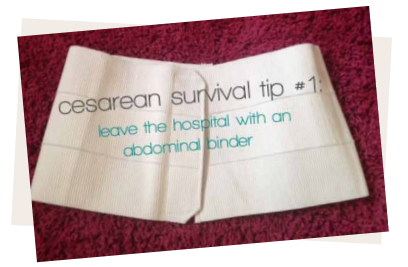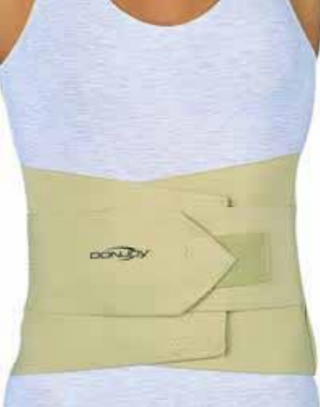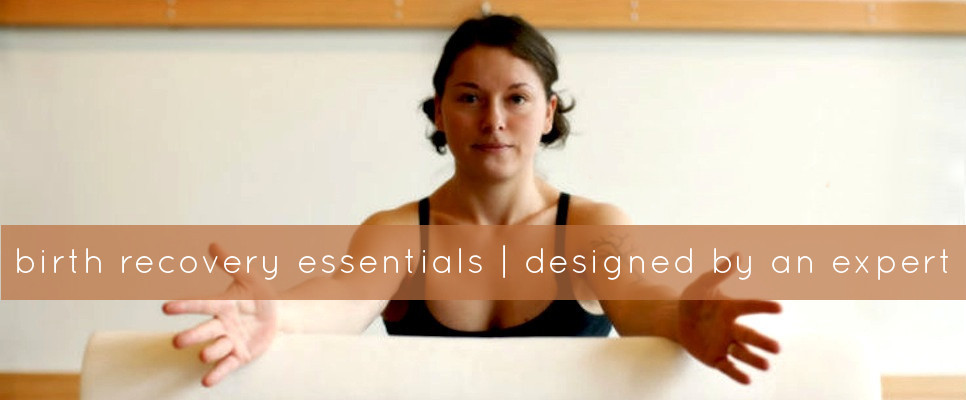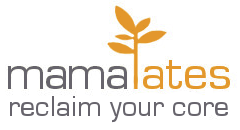“Cesarean Survival Essentials: postpartum binding” by Wendy Foster
This article is a reprint from the Winter 2015 edition of The Clarion, the official publication of ICAN. Become a member today to support ICAN and to subscribe!
As a former volunteer EMT, I was taught to ensure the scene was safe before entering; scanning the environment and weighing the risks before proceeding. We all do this as mothers, during labor and beyond. Most women don’t go into labor feeling like rock stars in amazing shape. We go into labor already tired from nine months of pregnancy, with separated abdominals and a body that’s out of alignment from carrying around a new little human.
One out of three women in the U.S. give birth by cesarean. Many experience infections at their incision, back problems, pubic symphysis, and pelvic floor issues. Hence, the postpartum scene is not safe to enter. But we have no choice. We must proceed and immediately call for backup.
There are so many articles, websites, and online forums with recommendations on the best ways to recover from a cesarean. Perhaps you’ve heard some of these words of wisdom: “Don’t lift anything heavier than your baby.” “Keep your incision clean and dry.” “Manage your pain.” “Eat healthy foods and get moving.” “Wait! Don’t do too much too soon.” While these are helpful hints, they fail to take into consideration that your body needs support, both emotionally and physically, to heal.
Fortunately, there are amazing resources like ICAN that provide emotional support during the recovery period. However, as far as physical recovery, I’d like to suggest that the most important support that you can provide for yourself is as simple as practicing abdominal binding.

Binding around the globe
Postpartum binding is practiced in many cultures throughout the world. For centuries, women have found that binding provides support and stability for the back and core muscles, which are often weak and likely separated after pregnancy. U.S. women wore girdles or corsets, which acted as binders, through the 1970s. Many Asian cultures believe postpartum binding is a way of re-containing and providing extra warmth for healing the internal organs. Supporting the core muscles physically, through binding, is key in recovery from a cesarean.
Begin binding ASAP
Abdominal binding can be used throughout pregnancy to support the growing baby and uterus. After the birth of your baby, Dr. Lara Williams, Oregon-based OB/GYN and mom of two, recommends binding as soon as one to two days postpartum to help support the core and the cesarean scar.
Dr. Bucko, a Board Certified Plastic Surgeon, recommends binding immediately post-cesarean and for at least 3-6 weeks thereafter. Randomly selected patients who wore binders after a “tummy tuck” demonstrated an enhanced post-operative walking experience (faster recovery to ambulation) and reduction in stress and in pain. Dr. Bucko also notes that his patients experience a great sense of security and confidence while wearing their binders.

Binding promotes stability and recovery
One of the mamalates goals of restorative birth recovery is stability. I have found that postpartum binding can help the new mother maintain pelvic stability and reduce swelling, while protecting the scar and low back. One common trait that most women who birth via cesarean share is the need to lift with their shoulders and back, instead of their core. The shoulders and ribs slide up and round forward and the pelvis is tucked to protect the incision. This happens during nursing, feeding, lifting, and even sitting and can cause back, pelvis, and neck pain. It’s very challenging to engage the core to lift and carry after major abdominal surgery!
Binding is a very therapeutic solution for this. It provides support to a weak core, while reminding mom to retain her alignment, helping to stabilize the shoulder girdle and pelvis while providing manual support.
Binders come in many varieties
Although many insurance companies are now reimbursing for birth recovery items like abdominal binders, don’t feel that you need to go out and buy one that’s new and fancy! Remember, women have been binding for centuries using simple materials. Here are a few suggestions for items that you can use to bind or wrap for the first four weeks post-cesarean:
- Moby wrap baby carrier
- Jersey sheet/material
- mamalates essential abdominal binder
- Old yoga pants
- Hospital binder
If you decide to purchase a new binder, save your receipt and submit it to your insurance company for reimbursement—especially if you’ve met your deductible from surgery this year.
Cesarean binding tips and tricks
If you have a binder available immediately postpartum, you can place a lightly wrapped soft ice pack between your scar and the binder to hold the ice in place. A light wrap is all you need post-cesarean if your abdominals are not separated. If you’ve determined that you have an abdominal separation of two or more fingertips wide, you’ll need a more therapeutic/structural binder that can help bring the muscles back together.
Whether you have a scheduled or unplanned cesarean you need to keep the postpartum scene safe, call in your back up, and remember:
- Ask your healthcare provider for a binder before you leave the hospital—don’t assume they will offer one to you.
- Also ask them what stretches you CAN do within the first 6 weeks to help facilitate recovery.
- Have your insurance pay for the binder or reimburse you if you pay for one out of pocket.
- Share this information with your friends and sisters so they are prepared.

 WENDY FOSTER is the founder of the mamalates method and the master trainer for all mamalates workshops and licensing programs. An internationally certified Pilates instructor, pre/post fitness specialist, and birth recovery expert, Wendy has been teaching Pilates since 1999 and practicing yoga for nearly two decades. She has had a cesarean and a VBAC. She owns a studio in Southeast Portland, OR. Contact her at wendy@mamalates.com or visit mamalates.com. Find a mamalates class near you!
WENDY FOSTER is the founder of the mamalates method and the master trainer for all mamalates workshops and licensing programs. An internationally certified Pilates instructor, pre/post fitness specialist, and birth recovery expert, Wendy has been teaching Pilates since 1999 and practicing yoga for nearly two decades. She has had a cesarean and a VBAC. She owns a studio in Southeast Portland, OR. Contact her at wendy@mamalates.com or visit mamalates.com. Find a mamalates class near you!
